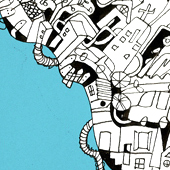It could be treated differently by different artists depending on their chosen theme. The choice will obviously depend upon the nature of the space and its audience. Whether it is a school, or an office, or just a fun community activity in the city centre. The visual could be socially relevant, or just a drawing of favourite idols, or even a way to express personal opinions. A visual can be sketched out effectively to suit the space and communicate whatever the artist wishes to. He has to decide which elements need to be big, which remain small and detailed, the flow of eye movement across the visual and the parts of the visual that could be exaggerated. Colours should be well thought of, does the visual demand vibrancy or just the boldness of black and white?
A lot of street painting artists create and compose directly onto the wall, and their creations are an intuitive form of expression. This process is similar to an artist creating a work of art on a canvas. But just as in any design process, if a mural needs to be created for a specific function or purpose, following a process helps. So a good understanding of the distance of viewing and the space along with the theme can give birth to a good design and help in the execution to bring this design to fruition.

Fig: You can have a sketchbook with some images, inspirations and ideas jotted down.

Fig: This artist could have taken inspiration from certain forms, elements, words etc, before creating the image

Fig: Using a reference image is also helpful. For instance, this wall art created in a street in Mumbai depicting Amitabh Bachchan was created from his movie poster - 'Deewar' a Bollywood film.
• Sketching in a book helps in visualizing.
• Once some elements are fixed on paper they could be scanned and digitized, the entire visual could be created bit - by - bit on the computer.
• The exact dimensions of the wall can be mapped into a grid which could be used as a reference layer on Adobe Photoshop (or any similar image editing software). The created visuals can be fit onto this grid which can be used while actually painting on the wall.
This process is also extremely useful and fun when doing collaborative projects. One can get a clear idea how the different styles of the collaborators can be fused within the same space even before the actual work on the mural is commenced.

